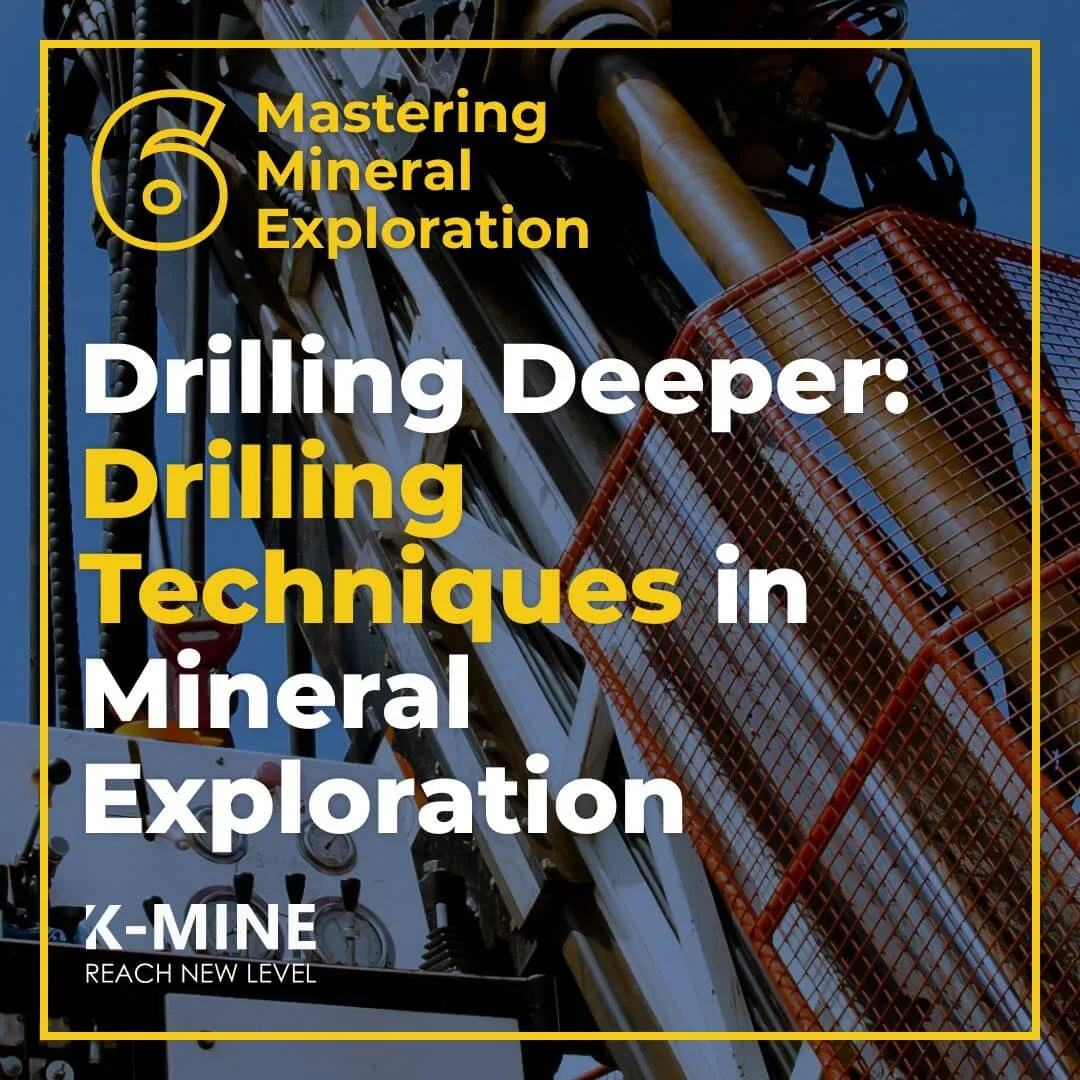
Content
- Drilling – The Backbone of Mineral Exploration
- Core Drilling – Unlocking the Secrets of the Earth
- Reverse Circulation Drilling – Fast and Furious
- Percussion Drilling – Old Faithful
- Auger Drilling – The Surface Scratcher
- Safety and Environmental Considerations
- Challenges and Innovations
- Future Trends in Drilling Technology
- Conclusion
Ah, drilling, the lifeblood of mineral exploration! Without it, we geologists would be left scratching our heads, and more importantly, the surface. You see, drilling is more than just making holes in the ground; it’s akin to taking a journey through time and unearthing the very treasures that our Earth holds.
Let’s wind the clock back to ancient times when our ancestors began dabbling in mineral exploration. Around 4,000 years ago, the ingenious folks in ancient China and Egypt made use of chisels and hammers to pound into rocks. It was laborious, to say the least. Fast forward to the 12th century, and we got the first glimpse of mechanical drilling in the form of percussive drilling. The leaps didn’t stop there, with rotary drilling making an entrance in the late 1800s, which brought us the capability to delve deeper and extract core samples.
In the 20th century, the drilling world saw a veritable explosion of technology. We had diamond drilling, reverse circulation drilling, sonic drilling – you name it! These advancements, well, they were a game changer. They meant that we could extract increasingly detailed data, and do it faster and safer than ever before.
Today, drilling techniques are more sophisticated than a fine Scotch. From automated drill rigs to real-time data analysis, the modern geologist has a veritable toolbox at their disposal.
But let’s not get ahead of ourselves; there’s plenty of time to dive into the details. What’s critical to understand is that drilling is the linchpin in mineral exploration. It gives us the invaluable data needed to ascertain what’s below the surface. Whether it’s finding a new copper deposit or unearthing a diamond mine, drilling is, and always will be, fundamental to cracking Earth’s code.
As we journey through this article, we’ll delve into the various drilling techniques, explore how they’ve been honed and perfected, and even cast an eye towards the future.
Stay with me, fellow rock enthusiasts, as we drill down into the bedrock of mineral exploration.
Drilling – The Backbone of Mineral Exploration
Drilling, undoubtedly, is the backbone of mineral exploration. It represents the essential phase where we, as geologists, can finally pierce the veil of the overburden and lay our hands on the rock that has so much to tell. Without drilling, the stories locked in the depths of Earth’s crust would remain untold, and its rich mineral endowments unrevealed.
In the pursuit of understanding a mineral prospect, surface information and indirect methods can only take us so far. Drilling provides us with the means to directly sample the rock in situ, often hundreds or even thousands of meters beneath the surface. This direct access is invaluable. The cores and rock chips retrieved through drilling are the very essence of the geological investigation. They hold the keys to the mineralogy, geochronology, geochemistry, and structural geology of the deposit.
Drilling data is the linchpin that holds the exploration venture together. The geological data extracted from drill cores include visual estimation of mineral percentages, identification of mineral associations and alteration minerals, determination of lithologies, and recording structural data. It also enables us to evaluate the geotechnical aspects that are critical for mine design, such as rock quality, fracture orientations, and hydrogeological properties.
What’s more, the drilling phase represents a significant financial undertaking. The direct costs associated with drilling can often make up a substantial portion of the exploration budget. Therefore, it is critical that the drilling is meticulously planned, and the data acquired is effectively utilized. Herein lies the true value of drilling – the information gleaned can be the deciding factor that propels a project from an exploration play to a mine under development. Conversely, it can reveal fatal flaws that render the prospect uneconomic.
In my two decades of experience, I have seen projects transformed on the back of well-executed drilling programs, just as I have seen projects falter and fail when the intricacies of drilling were not accorded the attention they warrant. It’s no exaggeration to state that in the realm of mineral exploration, drilling is where the proverbial rubber meets the road.
Now, let’s delve into the arsenal of drilling techniques at our disposal, each with its own set of advantages, applications, and limitations. From Reverse Circulation to Diamond Drilling, these methods form the toolkit that enables us to extract the subterranean secrets and assess the viability of mineral prospects.
Core Drilling – Unlocking the Secrets of the Earth
If there’s one technique that has been instrumental in shaping our understanding of the Earth’s subsurface, it’s core drilling. At its most basic, core drilling is a system that lets us extract a continuous cylinder of rock—a core—from hundreds to thousands of meters beneath the Earth’s surface. It’s akin to taking a biopsy of the Earth, offering a snapshot of the geological processes that have taken place over millions of years.
In mineral exploration, one of the most widely used core drilling methods is diamond core drilling. This is a robust technique that utilizes a drill bit embedded with industrial diamonds. The bit grinds away the rock, and the resulting core is a near-perfect sample of the geological strata that the drill has traversed. This core provides a treasure trove of data that we geologists pore over, from the color and density of the rock to the size and orientation of mineral grains.
It’s a painstaking process, but it’s an exciting one. The cores retrieved give us tangible, unaltered samples of the subsurface geology. When we examine these samples, we’re looking for indications of mineralization – the presence of economically viable minerals. But we’re also looking at the bigger picture, trying to decipher the sequence of geological events that led to the formation of these minerals. This information is invaluable for building a conceptual model of the mineral system, which forms the backbone of any mineral exploration project.
A significant advantage of diamond core drilling is the quality and integrity of the samples it provides. The cores are typically well-preserved and provide a continuous record of the rock sequence, which can be crucial for understanding the structural geology and the context of the mineralization.
However, like all techniques, diamond core drilling has its challenges. It can be a slow process, particularly at greater depths, and it is often more expensive than other drilling methods. Nevertheless, the depth penetration and the high-quality samples it yields make it an essential tool in our exploration toolkit.
Remember, each drill core tells a unique story. As geologists, our role is to piece together these stories, building a coherent narrative about the geology of the area and the potential for mineral resources. And core drilling is an invaluable chapter in that narrative. Next, we’ll look at how other drilling techniques, such as reverse circulation drilling, contribute to this complex geological story.
Reverse Circulation Drilling – Fast and Furious
Alright, let’s shift gears and talk about another workhorse in the realm of mineral exploration – Reverse Circulation or RC drilling. If core drilling is the precision scalpel of our toolkit, then think of RC drilling as the sledgehammer – it’s faster, and it’s employed when we need to make rapid assessments of the geology over large areas.
RC drilling employs dual wall drill rods that serve a dual purpose. The inner tubes provide a route for the drill cuttings to be transported to the surface, while the outer tubes force high-pressure air down the borehole. This high-pressure air ensures that the sample isn’t contaminated with other materials as it’s forced up the inner tube. The result? A rapid retrieval of rock chips.
Now, let’s be clear; RC drilling doesn’t provide the pristine, continuous samples that we get with core drilling. Instead, we get rock chips, which are still very informative but come with some limitations. For instance, the rock chips don’t provide the same level of structural information that core samples do.
So, where does RC drilling fit into the broader exploration strategy? Firstly, it’s excellent for the initial stages of exploration when you’re trying to get a rough idea of the geology over a wide area. It’s like taking a reconnaissance survey of what’s beneath the Earth. Additionally, RC drilling is often employed for in-pit grade control in a mining scenario. The speed of RC drilling allows for quick delineation of ore zones to assist in mine planning.
But speed isn’t the only merit; it’s also more cost-effective compared to diamond core drilling, especially when drilling to shallow depths. This can be particularly useful in the early stages of an exploration project when the budget might be tight.
However, RC drilling has its limitations. For instance, it’s not as effective in unconsolidated formations, where the borehole can collapse. Additionally, in areas with high water flow, getting a representative sample can be challenging due to the washing away of cuttings.
In the world of mineral exploration, time and resources are often of the essence. Reverse Circulation drilling allows us geologists to efficiently gather subsurface samples and make informed decisions on the potential of mineral deposits. When combined with other drilling techniques and geological data, RC drilling becomes an essential part of a multifaceted approach to unlocking the secrets of the Earth’s bounty.
Percussion Drilling – Old Faithful
Every toolbox has its old reliable, and in the world of mineral exploration, percussion drilling, also known as cable tool drilling, fits that bill. The old saying, “If it ain’t broke, don’t fix it,” applies here. This is a time-tested technique that dates back centuries, and let me tell you, even in our modern, high-tech world, percussion drilling still has its place.
So, what’s the premise behind percussion drilling? It’s pretty straightforward – raising and dropping a heavy drill bit into the borehole to pulverize the rock. Yes, it’s as simple and brute as it sounds. A cable is used to repeatedly lift and drop a heavy chisel-shaped drill bit into the borehole. The pulverized rock fragments, known as drill cuttings, are then removed from the hole using a bailer.
Now, you might be wondering, why would a seasoned geologist opt for such an old-school method? Well, when you are exploring in remote areas with limited access, sometimes simpler is better. Percussion drilling rigs are generally more compact and can be manually operated. They don’t require the same level of infrastructure that more advanced drilling techniques do. This makes them ideal for initial exploratory work in remote or hard-to-reach areas.
Another advantage of percussion drilling is its relatively low cost compared to more sophisticated methods. Budget constraints are a real consideration in exploration projects, and being cost-effective can sometimes tip the scales in favor of using percussion drilling.
Moreover, in certain geological settings, such as very hard rock or highly fractured zones, percussion drilling can be more efficient than rotary techniques. Its sheer simplicity also means there are fewer things that can go wrong, which is a boon when you’re in the middle of nowhere.
But let’s not romanticize too much; percussion drilling has its downsides. It’s slower than modern drilling techniques, and the samples it retrieves are not as clean or as well-preserved as what you would get with, say, core drilling. The lack of continuous sampling is also a limitation, particularly for detailed geological studies.
So, when might this old faithful be the right choice? In the hands of an experienced geologist, percussion drilling can be an effective tool for preliminary exploration in remote areas, especially when dealing with extremely hard rock or when simplicity and cost-effectiveness are paramount. While it might not be the star of the show, it’s a technique that has stood the test of time and continues to serve us well in certain circumstances.
Auger Drilling – The Surface Scratcher
Let’s shift gears and talk about auger drilling, which I like to call the “Surface Scratcher.” If mineral exploration were an archaeological dig, auger drilling would be akin to carefully dusting off the upper layers, picking up the pieces closer to the surface.
Auger drilling is a method that involves using a drill bit with helical screw blades – the ‘augers’. When the drill turns, the blades cut into the earth, and as they rotate, they lift the cuttings up and out of the hole. Think of it like a giant corkscrew pulling the cork out of a bottle, but instead of a cork, it’s the soil and unconsolidated rock we’re dealing with.
Now, as an experienced geologist, let me tell you why auger drilling holds its own in the exploration arsenal. First and foremost, it’s a fantastic method for collecting samples from the upper layers of the subsurface. When the project is in its early stages, and you’re looking to gather information on soil composition or unconsolidated material, auger drilling can be your best bet. It’s particularly effective in areas with a lot of sedimentary cover where you need to get through that upper layer to reach the bedrock.
Another perk is the minimal environmental disturbance. The method is relatively non-invasive and is often favored in environmentally sensitive areas. In an era where sustainability and environmental consciousness are at the forefront of mining practices, this is not a point to be glossed over.
Auger drilling is also known for its speed and efficiency in the right conditions. It’s often less time-consuming compared to other drilling methods, especially when dealing with softer materials.
However, it’s essential to acknowledge that auger drilling has its limitations. It’s not suitable for hard rock or very deep exploration. The samples you retrieve are from near the surface, and while that’s invaluable information, it’s just a part of the puzzle.
In the grand scheme of mineral exploration, auger drilling often plays a complementary role. Think of it as a reconnaissance mission gathering intelligence. It can be effectively used in tandem with other, deeper-reaching methods. By combining the surface data from auger drilling with subsurface data from core or RC drilling, you, as a geologist, can put together a more comprehensive picture of the geology and mineral potential of an area. It’s all about using the right tools at the right time, and auger drilling has a well-earned spot in the geologist’s toolkit.
Safety and Environmental Considerations
Any seasoned geologist who’s spent time on a drilling site knows that, alongside the thrill of discovery, comes the weight of responsibility. Drilling is no small feat, and it’s incumbent upon us in the industry to respect the ground we tread upon, both in terms of the natural environment and the safety of our fellow drillers and geologists.
Let’s get straight into the nitty-gritty: drilling can be hazardous. We are dealing with heavy machinery, high pressures, and often unpredictable geological formations. Risks include, but are not limited to, equipment malfunctions, falling objects, slips and falls, hearing damage from the noise, and even exposure to harmful materials. The potential for groundwater contamination and surface disturbances are also inherent challenges we face.
So, what do we do about it? Safety and environmental stewardship need to be a culture, not just a checklist. Comprehensive safety training and constant vigilance are the first lines of defense. Wearing proper personal protective equipment (PPE) – hard hats, safety glasses, gloves, and steel-toed boots – is a must. Regular maintenance and inspection of equipment can prevent a lot of heartache.
Now, when it comes to groundwater protection, drilling techniques and practices have evolved to minimize risks. For instance, we use drilling fluids to stabilize the borehole and prevent the walls from collapsing, but it’s imperative to choose these fluids judiciously to avoid contaminating the groundwater.
Erosion control is another significant issue, especially in areas with loose surface material. Strategic placement of silt fences and employing revegetation techniques post-drilling can be quite effective.
Noise and air pollution are often overlooked but are just as vital. Noise barriers and choosing low-noise equipment can make a substantial difference. Reducing equipment emissions and having efficient dust control measures are steps in the right direction for air quality.
The integration of technology has been a boon for safety and environmental protection. Remote-controlled equipment can significantly reduce the necessity for personnel to be in high-risk areas. Advanced monitoring systems can provide real-time data on equipment performance and environmental conditions.
In summary, the stewardship of the environment and the wellbeing of personnel are not just ethical obligations but are integral to the sustainability and long-term success of any mineral exploration venture. We geologists and industry professionals must be the custodians of best practices, ensuring that the quest for mineral resources is conducted with the utmost respect for the land and our fellow professionals. It’s about striking a balance and ensuring that our legacy is one of discovery and innovation, tempered with responsibility and care.
Challenges and Innovations
For the geologist who’s been knee-deep in the drilling mud, it’s crystal clear that drilling is not a one-size-fits-all operation. The Earth doesn’t give up its secrets lightly, and the challenges faced in drilling operations are as varied as the minerals we seek.
One of the key challenges in drilling is the heterogeneity of rock types and the unpredictable nature of the subsurface. Different materials demand different approaches. Drilling through a relatively soft sedimentary layer is a far cry from trying to penetrate a quartz-rich, hard rock environment. The latter can be a real test of our mettle and equipment. The wear and tear on drilling bits in these situations can be relentless, leading to frequent equipment failures and downtime.
Lost circulation is another headache that keeps geologists on their toes. When drilling through fractured rock or highly permeable formations, the drilling fluid can escape into the rock. This not only impacts the stability of the borehole but also throws a wrench into the economics of the operation.
Dealing with substantial overburden is also challenging. Sometimes, the valuable geological formations are buried deep under layers of unconsolidated material, making it tough to get to the good stuff without a protracted and costly ordeal.
Enter the innovations. Oh, how the drilling world has changed!
Take, for instance, the advancements in drilling bits. We’ve got diamond-impregnated bits that laugh in the face of the hardest rocks. These bits use industrial-grade diamonds to literally grind through the rock. The lifespan of these bits is substantially longer than traditional ones, reducing the downtime required for changes and maintenance.
Then, there’s automated drilling systems. Imagine a rig that can adjust its operation in real-time as it encounters different rock types. By automating the drilling process, we can optimize drilling speed and bit pressure to enhance efficiency and minimize wear.
Lost circulation materials (LCMs) are another breakthrough. These are special additives mixed with the drilling fluid to prevent its loss into the rock. These LCMs effectively plug up the fractures and pores, keeping the fluid where it’s needed – in the borehole.
Sonic drilling is yet another innovation worth mentioning. This method uses high-frequency vibrational energy to advance a core barrel or casing into the subsurface. This is particularly useful for drilling through unconsolidated overburden, as it allows for continuous core samples and reduces the risk of borehole collapse.
In essence, the challenges in drilling operations are incessant; but innovation, driven by the collective wisdom and ingenuity of geologists and engineers, continues to push the boundaries. We are in an age where technology is our ally in tackling the enigmas of the Earth. It’s a thrilling time to be a geologist in the realm of drilling. The treasure trove beneath our feet awaits, and our tools and knowledge are sharper than ever.
Future Trends in Drilling Technology
As we stand on the precipice of a new era in drilling technology, it’s hard not to feel a sense of exhilaration. The winds of innovation are blowing, and they carry the promise of revolutionizing the way we drill into the Earth’s crust. The toolbox of the modern geologist is ever-evolving, and here’s a glimpse into the future trends in drilling technology.
- Real-Time Data Analytics: The future is digital. The integration of sensors and real-time data analytics into drilling operations is a game-changer. Imagine having live data on drill bit performance, rock characteristics, and fluid dynamics at your fingertips. This wealth of information enables informed decision-making on the fly, maximizing efficiency and potentially unveiling new insights into subsurface geology.
- Artificial Intelligence (AI) and Machine Learning (ML): AI and ML algorithms have the potential to learn from the colossal datasets generated during drilling operations. These technologies can be used to predict equipment failure, optimize drilling parameters, and potentially identify patterns that could indicate the presence of mineralization.
- Environmentally Friendly Drilling Fluids: Environmental stewardship is no longer an option; it’s a necessity. The development and use of biodegradable and environmentally friendly drilling fluids reduce the ecological footprint of drilling operations. Such advancements are crucial in ensuring the sustainability and social license of mineral exploration activities.
- Enhanced Automation and Robotics: Fully or semi-automated drill rigs are not science fiction – they’re becoming a reality. Robotics and automation in drilling operations can lead to more precise drilling, reduced human error, and increased safety by limiting human exposure to hazardous conditions.
- Advanced Material Technologies: The development of new materials for drill bits and other components can significantly enhance the durability and performance of drilling equipment. Imagine bits made of materials beyond diamonds, designed at the molecular level, for maximal efficiency and lifespan.
- Drone-Based Drilling Platforms: Drone technology is advancing at a breakneck pace. The prospect of using aerial drones for drilling in inaccessible or hazardous areas opens up new possibilities for exploration. These drones could be deployed to perform initial sampling in areas that would be risky or logistically challenging for human teams.
- Deep Earth Drilling: As the easy pickings have been picked, the future of mineral exploration lies deeper than ever before. Technologies that allow for ultra-deep drilling operations will be crucial in uncovering the mineral deposits of tomorrow.
It’s crystal clear: the drilling sector is poised for a renaissance. The integration of cutting-edge technologies and materials, coupled with a renewed focus on environmental sustainability, is set to propel the drilling industry into uncharted territories. For the geologists of today and tomorrow, these advancements not only signify new tools in our arsenal but also represent a commitment to responsibly unlocking the Earth’s bounty. Hold on to your hard hats; it’s going to be a wild ride.
Conclusion
As the geological hammers come to rest and the drill rigs power down, it’s time to reflect on the journey we’ve taken through the enthralling world of drilling techniques in mineral exploration. The sheer diversity of methods at our disposal, each with its own set of attributes and applications, is a testament to the ingenuity and tenacity that have characterized the field of geology for centuries.
Drilling is much more than merely putting holes in the ground; it’s an art form that bridges the gap between the unknown and the known. It’s through drilling that we, as geologists, can extend our senses deep into the Earth, deciphering its secrets and shaping our understanding of the world beneath our feet.
With a keen eye on the horizon, it’s evident that the future of drilling is as bright as a freshly polished core sample. The integration of cutting-edge technologies, coupled with a global emphasis on sustainability, signals the dawn of a new era in mineral exploration. From real-time data analytics to AI, from advanced materials to drone-based platforms, innovation continues to be the bedrock of our profession.
As we conclude, it’s important to acknowledge that drilling, while indispensable, is but a single cog in the machine that is mineral exploration. The raw data and samples obtained through drilling need to be efficiently managed and meticulously analyzed to unlock their true value. That’s why, in the next installment of this series, we’ll delve into the fascinating realm of data management in mineral exploration. It’s here that the data, extracted through sweat and steel, undergoes alchemy, transforming into precious knowledge that guides our quest for mineral wealth.
So, grab your notebooks and sharpen your pencils, as we prepare to embark on yet another expedition into the depths of mineral exploration. See you on the other side!



 Back
Back